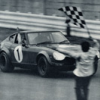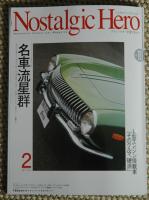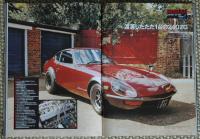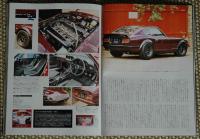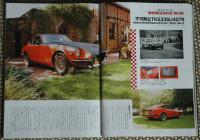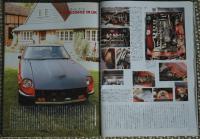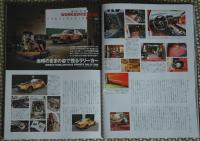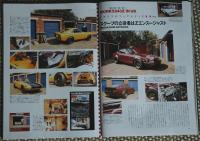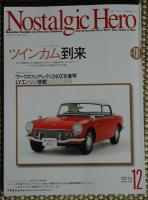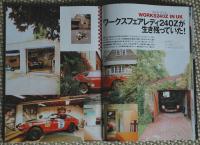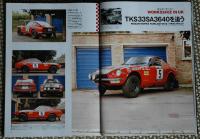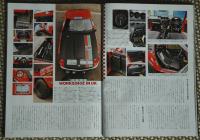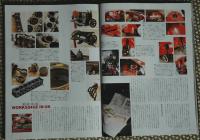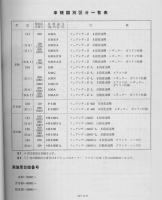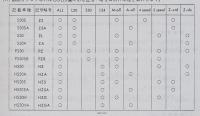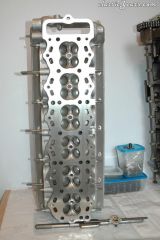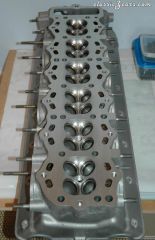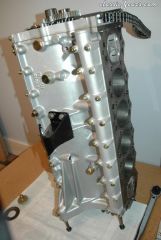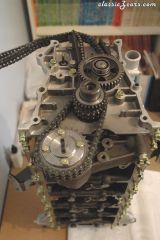Everything posted by HS30-H
-
Hello and I got a question
1969 and 1970 year production 'Fairlady Z' ( S30-S base model ) and 'Fairlady Z-L' ( S30 luxury model ) both shared the 'S30' VIN prefix. The trim and accessories ( and some of the mechanicals up to a point ) will help you to differentiate between the two. I'd expect a 1969~1970 build car to have a number between 'S30-00001' and 'S30-04504' Also take a look to see if the engine-bay VIN plate is still present - it is attached to the driver's side inner wing ( fender ) and those on Japanese-market cars are written in Japanese ( but the VIN is in a combination of roman letters and arabic numerals ). This plate might also have some extra information to help you identify the car, as the Japanese taxation class data is coded into it. I'd try to find the engine number too. You will find this stamped on a cast pad at the rear area of the block, just underneath the cylinder head / block joint and on the side of the engine that has the spark plugs. Try to get the full number and the prefix too. There is always the slight possibility that it could actually turn out to be a 1971 build-dated car, and if it was built towards the end of the year then there is the added complication that it could be a 'Fairlady 240Z' ( HS30-S model ) or 'Fairlady 240Z-L' ( HS30 model ) - which both used the L24 engine and both shared the 'HS30' VIN prefix. Again, VIN number will tell the tale and trim / accessories present or not present will tell the rest of the story. If it is an RHD Export-market car made in the 1969~1973 period, then it will have an 'HS30' VIN prefix too. Let us know how you get on.
-
Hello and I got a question
Why? You make it sound like that would be a disaster. It could be quite the opposite. dashtonn, I'd say the most important thing here is a 100% positive identification of model and specification. Then you know what you are dealing with. See if you can find the full VIN number / body serial number stamped on the firewall of the car ( above the brake booster, underneath a few wires and tubes ). That will help us to positively identify the model. The trim and accessories will help to identify the specification. There are people here that can help you pin it down. The key point there being the "......in North America....." bit. A true 1969 or 1970 build date RHD Z car ( yes - especially even a 'Fairlady Z' or 'Fairlady Z-L' ) is worth MORE in overall world terms than an LHD model in similar condition. That's a function of rarity, desirability ( outside the USA/Canada ) and the relative weak exchange rate of the $US at the moment. So all one needs to do is put the car in front of the right buyer. dashtonn, if it really is a 1969 or 1970 build-dated RHD model, then I would be interested in buying it myself. Just thought I'd give you a little encouragement to show you that it is just a matter of putting the car in front of the right people should you ever wish to sell it. Good luck, Alan T.
-
Yahoo japans CLEANEST.
Woah, slow down there. Don't raise false hopes and unrealistic expectations. Since when was the current highest bid on an unfinished auction a "price"? Especially when ( as Alfadog pointed out ) you can see that it is MILES away from his B.I.N. price.............. Nice! I'll give that my QC hanko any day of the week. Do it. :classic:
-
question about the G-nose
Maybe you don't, but you might need to make an appointment with a doctor to get his opinion on the symptoms of Tourette's Syndrome that you are displaying. :classic:
-
Correct Color Of Tailight Panel Nd Grill?
Its got a fair amount of what I would call black in it. Depends how well you stir it, and how deep your mixing stick goes into the slurry at the bottom of the can before you drip it over the side. Not much point in me taking a colour photo of the colour and posting it here, really. I don't think it would prove anything. The subtleties are too fine in daylight, let alone on a computer screen. It is a colour that is claimed to be 'Nissan Jidosha, Charcoal Grey Metallic' for the detail parts on a factory ZG, however. That'll do for me. :-)
-
Correct Color Of Tailight Panel Nd Grill?
-
Alan Thomas . . . is that you?
Eric, They were not the kind of profile that I was after for the GT-R ( so I went with the Avons ), but the re-released versions of the classic MICHELIN TB15, TB5 & TB5 F&R might be good for you. DOT ( USA ) legal too, I believe: http://www.longstonetyres.co.uk/michelintb15.php Alan T.
-
Alan Thomas . . . is that you?
Lachlan, Did I mention to you that Masuda san ( Editor-in-Chief of Nostalgic Hero ) was talking to me about your contribution? He was very happy that you had gone to the trouble of contacting the magazine and reported what was going on in your homeland. He's looking forward to more. Nice job. There's a lesson for us all there somewhere. We probably need to be more proactive. Alan T.
-
Alan Thomas . . . is that you?
Eric, Those wheels are now on the KPGC10, with new road-legal Avon ZZR tyres. Had a slight drama with the ride height ( it was very low, having been set for use with slicks ) but that is now resolved. Max, you'll need to be looking out for a silver Audi A4 Avant Quattro ;-) But seriously, contact me nearer August and we might be able to arrange for you to see my cars in London? The 432R-replica might even be running by then ( famous last words ). Gav, Kevin's car ( the '71 RAC car ) is nearing the end of a major restoration, and is being put back to its '71 RAC spec and livery. Kevin is taking this down to some intricate detail, including the replication of a UV-sensitive paint daub applied by the scrutineers at the start of the rally. His attention to detail is stunning. He's missing one Koito spotlamp, which is proving very difficult to get hold of. They were originally made by Koito as aircraft parts, and even Koito in Japan have come up with nothing so far. I know an old guy who has a set, but he is proving to be difficult to persuade to part with them. Gary's car ( the '73 RAC car ) is a family heirloom and is something of a 'rolling resto' at this point. It has wonderful patina and it would be a shame to pull it apart at this point. Gary did some work on it in 2006 and it might be on the road again in 2007. Myself and Kevin have been trying to help Gary source some missing works parts for it, and this should help things along somewhat. Cheers, Alan T.
-
Alan Thomas . . . is that you?
None at all Ed. They are all Nissans....... :classic: If you ever find yourself in London, you would be most welcome to visit, of course. Goes without saying. Thanks for all the nice comments everyone, but I have to say the coverage of myself and my cars is nothing compared to the pages in issue no.118 covering Kevin and Gary's ex-Works cars. I hope you all realise just how special and historic those two cars are. The owners of the cars are not limelight-seekers by any stretch of the imagination, and for Nostalgic Hero to get the 'scoop' was a bit of an achievement really. I was very happy to be able to help arrange the whole thing, and the satisfaction of seeing the two cars ( as well as Kevin's yellow car - a car with over 30 years of continuous competition behind it, by the way - and not forgetting Gary's Nissan 240RS too ) finally given a really good article with great detail photos and explanations was great for me. We had a great time on the shoots and the whole thing went off quite well, so I was relieved. I think the article did the cars justice, although I'd have liked them to have used more of the period shots of the cars in action that I supplied them with - but you can't have everything. It would be nice if some of the English language car magazines would dedicate some space to a proper historically accurate, informative and visually appealing article like Nostalgic Hero managed with Kevin and Gary's cars. Alan T.
-
Alan Thomas . . . is that you?
-
Alan Thomas . . . is that you?
-
Alan Thomas . . . is that you?
-
Alan Thomas . . . is that you?
Lachlan, The KPGC10's arrival in the UK ( and the story surrounding it ) was one of the original reasons for the guys from Nostalgic Hero coming over to the UK this time. As you know, the car got a dedicated feature in issue no.113 ( with Mount Asama as the backdrop ) and it was discussed at the time that they would do a follow-up article with Dr Shimizu handing the car over to me after it arrived in the UK. At least five or six years ago I had introduced Kevin's ex-Works car to the previous editor of the mag, and we discussed Nos Hero getting a 'scoop' feature on the car when it had completed its restoration. Kevin's resto took years longer than first expected, and this was half forgotten about. However, with the Nos Hero guys thinking about coming over anyway for the KPGC10 it was good timing to kill more than two birds with one stone and the whole thing took on a new dimension. They became very excited about the chance to scoop Kevin's car at a very interesting point in its restoration ( body finished, but engine still in pieces ) and also be allowed to look at a couple of other ex-Works cars too. My good friend Matsui san ( who rebuilt the KPGC10 ) coordinated the Japanese side of the arrangements from the very beginning, and I coordinated the UK side. Unfortunately, at the last minute Dr Shimizu was forced to cancel his trip due to work commitments, so the KPGC10 hand-over coverage was put on the backburner and more pages were given over to Kevin and Gary's cars - which certainly deserve them. The whole shebang ended up at sixteen pages, which is quite unusually large. We also covered Gary's ex-Works Nissan 240RS ( chassis no.1 no less ) for Nos Hero's sister magazine for what they call 'neo historics'. They did put a little box into the article showing Matsui san with the KPGC10 in London, and a few comments on its arrival. Its a real pity that Dr Shimizu could not make it. It would have been nice to tie up the loose ends on that. They had planned a fairly cheesy 'KPGC10 in London' article with some famous landmarks in the background, so I might have to do that myself at some point in the future..... I didn't really want them to make too much fuss over the ZG, as I had been switching wheels and tyres around in something of a panic in the days preceding their visit and had actually ended up with two of the wheels from the KPGC10 ( wearing their big new Avon ZZR tyres ) on the back of the ZG - which are much too big! - and the rear wheels of the ZG on the front of the GT-R just so it would wheel around properly without tyres touching the overfenders ( it needs the ride height reset to suit the new road-legal tyres after switching over from modern slicks ). The ZG consequently looks a bit silly with the wrong rear wheels and tyres on it for the photos. I didn't even really get a chance to clean and polish it. My own fault. Here are some scans of issue no.118:
-
Alan Thomas . . . is that you?
Hi Miles and Lachlan, Yes, I admit it. It is me. Although I must say that they must have done some kind of Photoshop jiggerypokery to make me as ugly as I look in that photo. That's certainly not the handsome, fit, intelligent-looking adonis with a full head of hair and his own teeth that I see in the bathroom mirror every morning. They got my age wrong two issues running too ( I'm 44 not 41! ) so now people will be thinking I've been telling little white lies about my age too. :nervous: Actually, the four page coverage in issue no.119 is a kind of over-run from issue no.118 - which was the main course, if you like. Issue no.118 was Sixteen pages of UK-based feature, covering two genuine ex-Works 240Z rally cars ( Kevin's and Gary's ), plus Kevin's current MSA British Championship historic rally car, and my 432R replica project, my Fairlady 240ZG and the KPGC10 that Dr Shimizu has given to me. The guys from Nostalgic Hero spent three nights in London and then flew back to Japan, so it was quite a punishing schedule really. We were blessed with some fairly nice weather luckily. I must say I think the article on the ex-Works cars in issue no.118 is very impressive, and I'm really pleased that it all worked out so well. I might need to make some scans and put them up here for those that can't usually get hold of the mag. Might fill in the surrounding story of how it all came about too. Lachlan, I didn't see your original post about 118 ( I'm slacking ) - otherwise I would have replied to it. Sorry. Cheers, Alan T.
-
240Z Parts Variations
Enrique, Be careful about that 'U' suffix and what it denotes, as it can be misleading. Most importantly, note that it does not stand for 'USA'....... The plain ( no suffix ) 'HLS30' was the "European" market version of the '240Z' according to Nissan factory documentation - although it has to be said that the term "European" covered quite a lot of different territories and I know for sure that some of these differed slightly in spec as sold by the dealers....... Also note that the 'HS30-U' was an RHD Export '240Z' according to the same Nissan factory documentation. Nissan's factory workshop manual for the UK market '260Z' model shows that the letter U suffix obviously changed meaning at some point when applied to the different models. The manual says that the letter 'U' now meant "RHD". Confusing, isn't it? Zedrally, I think it was me that made the suggestion of a 'sticky' - but I was referring to the VIN suffixes and prefixes ( model variation ) subject rather than Will's original thread subject. I'd be happy to have a go at compiling the list of model variants that Enrique requested, but I'd prefer to stick to the RHD versions. Somebody else would have to take responsibility for the LHD versions in case I don't have all the necessary data on them. Any LHD volunteers out there? Will, Great thread subject! ( sorry to have diverted it somewhat ) and I think it certainly could do with being made more permanent, and probably should have its own web page......... Sounds like it has the potential to be your great Unfinished ( unfinishable! ) Symphony....... :-) Alan T.
-
Safari rally videos/pics
Jeremy, By far the best film footage of Nissan's works Zs on the East African Safari Rally were Nissan's own promotional films. They were made for the Japanese market ( Japanese language captions / titles and commentary ) and were shown in cinemas, dealerships and to clubs soon after the events were held. Nissan licensed M3 ENTERTAINMENT of Japan to produce DVD compilations of the '68, '69. '70 and '71, '72 & '73 films last year. They are available as a two DVD box set or single DVDs with three films on each. The '68, '69 & '70 films concentrate on the 510 Bluebirds whilst the '71, '72 & '73 films have the 240Z content. *MRBF-1038 = 68/69/70 ( total 51 minutes ) NTSC2 @ 4,725 Yen *MRBF-1039 = 71/72/73 ( total 58 minutes ) NTSC2 @ 4,725 Yen *MMSD-0020 = 2 dvd box set @ 9,450 Yen I bought mine in Japan, but you might be able to find an importer that will obtain them for you. Good luck, Alan T.
-
240Z Parts Variations
Happy New Year to you too, Christopher I didn't realise that I was apt to "jump down your case", and if that is the perception then I apologise. I'm certainly not singling you out for special treatment. I'm usually only trying to get things right for the benefit of us all and the doubtful posterity of the 'search' function, all the time with the Sword Of Damacles hanging over my head for daring to suggest that the S30-series Z cars are a family of cars with equal rights in terms of concept and design, rather than one 'supreme' deity and a bunch of "irrelevant" runts. You know what I'm talking about, don't you? As I'm sure you realise, I didn't open up the can of worms of the U/UN/UV and their Auto suffix combinations as pertaining to Canadian and Californian versions of the '240Z' because it is just that; a can of worms. I think the 'U' suffix covers them all for the sake of discussion until we want to start getting more specific, no? I don't really consider myself a specialist on the LHD Export models, and I'm sure there are people here better armed to explain the differences between the 'Ontario' market version of the 'HLS30 UN' and all the other UNs, for example. I saw a thread here the other day where a prospective purchaser was asking about the differences between the 'USA' market version(s) and Canadian versions(s) of the '240Z'. He got a few replies, but none answered the basic question. I felt sorry for him, as I know the answers should be readily available, but I didn't feel 100% confident that I would be the right person the attempt to address them...... To be honest, I'd expect to see more explanation and exploration of the suffixes on sites such as ours and - for example - zhome.com, but very few people seem to be au fait with them. Unlike the oft-used and abused "Series" designations, these prefixes and suffixes are FACTORY terms ( and therefore should mean something a little more concrete ) that would help us to understand what Nissan made - and even why they made them in some cases. Maybe we need to get our heads together and make a 'sticky'? The Japanese home market variants are particularly difficult to list up concisely, and they represent something of a moving target to boot. They have the most complicated variant listings, and buyers also had the possibility of choosing options and deletes that complicated matters still further. So - for example - Mr Suzuki could walk into a Nissan showroom in Sapporo in October 1971 and order an 'HS30 D', but decide to go with the 4-speed option instead of the standard 5-speed of that model, delete the radio and clock, but add a heated front screen as part of a 'cold weather pack' ( something not listed on the official printed options lists - but nonetheless available in certain areas of Japan ) and studded snow tyres. Trying to decipher Mr Suzuki's car 35 years later would prove rather difficult without having Mr Suzuki present to explain his choices to us. Here are a couple of charts to help illustrate the points I'm trying to make ( Enrique, I hope this helps to start answering your post without actually getting too far into it, as I think the subject demands its own thread or 'sticky' really ). Remember that this is just a snapshot of what was available in one market at one point in time ( October 1971 ). Note too that they do not even list ALL of the possible variants ( PS30-SB 'Z432-R' is not listed, for example ) and the subject of low / high compression variants and optional equipment is barely touched on. Note too the 'nickname' terms given to the major variants ( 'PZ', 'PZR', 'ZS', 'HZ' etc etc ) and used internally by Nissan on factory documentation, parts lists etc which might further confuse and confound until you start to get used to them. Will, I'm sorry if all this has diverted the original intentions of your thread somewhat, but I think the point needed to be addressed. Even if you end up sticking to the different 'HLS30-U' sub-variants for the 'Parts Variations' topic discussion, I think it is a good idea for us all to bear in mind the wider connotations of the term '240Z'. Alan T.
-
240Z Parts Variations
Will, Can I suggest that any such list makes it quite clear as to which '240Z' it includes? You don't appear to have mentioned this. Maybe it would be best to stick to the USA/Canada market 'HLS30U' versions ( making it quite clear what market version it applies to ), unless you want to include parts and specs relevant to European market 'HLS30' models - let alone RHD Export market and Japanese domestic market '240Z' models............... especially if the data might form part of the reference material to aid a 'judge' in assessing any particular car. It would be a shame if a non-USA/Canada market car was judged as 'incorrect' in spec because data pertaining to a different market was being used to judge it. Just a thought. Alan T.
-
Need Vin Help!!!!!!
Carl, So were you born in the USA or Germany? Just wanted to get it straightened out in my mind, as I remember you claiming - on this forum - to have been "German". I think the original quote was something along the lines of ".........being German myself.........". If only the Z cars that left Japan can be referred to as "from Japan" then maybe you'd better stick to being an "American" rather than "German"? Silly semantics is a tough subject to grasp once you start getting into it, don't you think? Frohe Weihnachten! Alan T.
-
Need Vin Help!!!!!!
They are all from Japan, 'GS30-003009' is a 'Fairlady Z 2/2' or 'Fairlady Z-L 2/2' ( close scrutiny of specification needed to discern between the two ) and it was built in the 1974 calendar year. It is more likely to be the higher-spec 'Z-L' version simply because so few customers in Japan chose to buy base-spec 2/2 versions......... Alan T.
-
S20 refurb
-
S20 refurb
- S20 refurb
- S20 refurb




